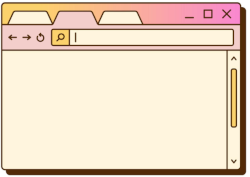Ted Nelson’s “Philosophy of Hypertext”
Rediscovering How the Web was Meant to be, from the Web's Original Visionary, 1960
by Tim Langeman (Sept 10, 2016, draft)
Who invented the Internet?

Every American history buff knows who invented the airplane, the telephone, and the light bulb. Americans like to think that their culture incentivizes and celebrates those inventors and creative geniuses that have propelled the world forward, yet about the piece of technology that has most influenced the world in the past 20 years, few Americans can answer the question “Who invented the internet?”
Oh, some people will sarcastically say “I thought Al Gore invented the internet”, not realizing that the political smear they repeat detracts from Gore’s very real role in converting the military’s ARPANET into the publicly-available system we today call the internet.
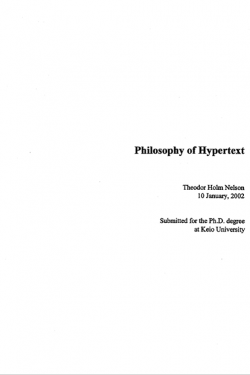
It is said that success has many fathers, but failure is an orphan
.
The history of the Internet is a variation on this theme – the
internet’s size and complexity required the work of many, but the one
man whose work is responsible for the web arriving several decades earlier
than it otherwise would have regards its design as a failure. This is not to
say that the internet we have today is not impressive or powerful, but as
Ted Nelson
writes in a newly-released publication of his 2002 Ph.D. thesis
“Philosophy of Hypertext”, today’s
internet is tied to bad philosophy – backward ways of thinking that
limit its potential. Ultimately, the world wide web is informed by the
philosophical and technical constraints of the past, resulting in a distorted
media platform.
Nelson wrote widely about Xanadu® — his proposed network of electronic documents — starting in the 1960s and 1970s, but the company that was commercializing his system in the 1980s fell under financial pressure and a simplified version — the world wide web — was adopted instead. Now, years later, Ted Nelson is still advocating a system, very much like his original proposal from the 1960s and 1970s. Nelson's system argues for:
- a built-in copyright meter to compensate creators,
- permanent, granular addresses to prevent broken links and allow granular annotation and remixing; and
- a browser that displays more than one page at a time, to allow readers to navigate more complex works without being disoriented by having to follow links away from the main piece they are reading.
Nelson’s central role in the development of the internet is described by Stanford Professor Paul Saffo in the following 12-minute video:
Paul Saffo: Internet Archive: “Possiplex” Book Launch (2010)About this Article
This article consists of a series of sub-sections that total about 39 minutes reading time when read in full,* or 16 minutes when reading the recommended core sections.
* (does not include time watching optional videos)
Ted Nelson is the person who most envisioned what we today think of as the internet. His insight was the result of an epiphany he had while a graduate student at Harvard in 1960. I leave it as an open invitation to scholars to explain the full source of Nelson’s genius; but it is easy to see that some of his creativity and early opportunities can be attributed to in his Emmy Award-winning television director father, Ralph Nelson, and Academy Award-winning actress mother, Celeste Holm, who gave him an advantage in envisioning our electronic future. When he was young, Nelson had the opportunity to shadow his father on the NBC and CBS television sets for shows that his father directed.1 The camera and television monitor were part of his growing up; and he directed his own 33-minute film while a senior at Swarthmore College. When Ted arrived at Harvard for graduate school, it seemed obvious to him that the computer monitors he saw *in the Harvard computer lab* were not just displays for textual computer output, but had the potential to display movies and all manner of electronic media.2
Nelson would go on to coin the word which he says came to me in 1962
,
as a way to describe electronic text that can be read non-sequentially using
connected text which we today think of as
hyperlinks — those
typically blue links on the internet that a user can click to access a
connected page.3
In 1974, Nelson would go on to self-publish the classic
Computer Lib/Dream Machines,
which had an enormous impact on the early computer industry. Before
Steve Jobs and Bill Gates started Apple and Microsoft, Nelson argued
that the future of computers lay in personal computers (not mainframes)
and an interconnected network of servers that would convey a
“docuverse”
of hypertext media. He called his hypertext system “Xanadu®”,
after the
capital of Kublai Khan’s dynasty in
Samuel Taylor Coleridge’s poem
“Kubla Khan” about a vision within a
dream. To Nelson, the Xanadu® Project represents the correct way to do
hypertext, even though the web has eclipsed it in the public mind.
There have been a number of visionaries whose ideas foreshadowed the web (see The Atlantic, May 2014). One significant figure was Paul Otlet. Another was Vannevar Bush. 3
In the July 1945 issue of The Atlantic, Vannevar Bush wrote an influential article titled “As We May Think”, that anticipated the information revolution. Though Bush described the revolution in terms of microfilm that could be distributed much more cheaply than available books and newspapers, his description of the connections or “trails” that readers could create for other readers remains unfulfilled to this day, except perhaps in Google’s ranking and auto-completion feature that often aids searchers as they enter query terms.4

Some readers will notice that up until this point, I’ve been conflating two terms — the “internet”, and the “world wide web”. Strictly speaking, the two are not the same. When most people think about the “internet”, they usually do not distinguish between the “world wide web” and “the internet”. One can think of “the internet” as the universe of connected computers, while “the web” represents those parts of the internet that can be accessed through a web browser like Internet Explorer, Safari, Firefox, or Chrome.
Keith Wagstaff writes:When you use an app on your phone, send an instant message, transfer a file directly from one computer to another via file transfer protocol (FTP) or simply send an email, you are using the Internet – but not necessarily the Web.
When you connect to the internet on your smartphone using your phone's built-in web browser, you are using the web, but if you open an app to check the weather, browse a map, or play Pokémon Go, you are still on the internet, but outside of the web. This distinction is an important concept to understand because publishing is moving beyond the web browser to mobile apps and e-readers. The magazines that you read may currently be available on the web, but books live in the enclosed environment of the e-reader; and many magazines offer paid subscriptions to an app-based version of their content. While some electronic publishing has historically taken place on the open web, this distribution mechanism risks losing commercial market share, particularly as publishers look for alternate ways to monetize their works.
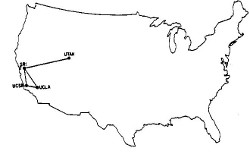
To fully appreciate what the internet is, consider that the internet predated the web, which Tim Berners-Lee released on the internet in 1991.
The internet started in the early 1960s as ARPANET, a military program that implemented Paul Baran's packet-switching network protocol. Baran worked at the Rand Corporation and was concerned that "one or a few nuclear bombs" would cut off communication, preventing diplomats from averting a full-scale nuclear war.5 He and others invented a series of protocols to allow messages to be broken into smaller chunks (packets) and sent across a network. In the event that one link in the network was destroyed, the system would find a way to route around the outage. While this was an important breakthrough, it was innovation at the transmission level, rather than at the content level, for it did not say anything about how the contents of documents would be structured or how the programs that interact with them should function. Tim Berners-Lee’s invention of the world-wide-web (www), published on the internet in the summer of 1991,5 introduced a format for hypertext (which at its most basic level is text with links in it) that has become the HTML standard. Just as important, Nelson says, (*source*) is Marc Andreessen’s development of the Mosaic browser, which standardized the web’s user interface. The Mosaic browser later became Netscape, and then Firefox; and though each version offered improvements, all the major browsers (Chrome, IE, Safari) remain patterned after, and limited by, Andreessen’s original one-page-at-a-time design.
A critical limitation of the Andreessen browser, and one I didn't appreciate until recently, is that you have to “leave” a page to follow a link. This means that for every link you “follow”, the source document disappears as the reader is transported, by what Ted calls a “jump link”. Ted calls this “jumping into the unknown.” In place of our current system, where the reader inspects the status bar and then blindly “follows” the link based upon a guess inferred from the link's URL, Ted argues for a system where the linked page would appear alongside the original on the right-hand side. He calls this “parallel documents” because you can read both the citing and cited documents together at the same time. (More on this later)
Tim Berners-Lee’s Contribution: HTML & the URL
Tim Berners-Lee was a software engineer at CERN,
the European Particle Physics Laboratory, who wanted to allow scientists
to share reports,
despite the fact that they operated on different computer systems.
His goal was not to lay the hypertext foundation of the internet
for all time; he merely wanted to allow the incompatible computer
systems at CERN to interoperate, so he took what Ted Nelson had proposed
for a hypertext system and radically simplified it to create
HTML
(hyper text markup language – the language web pages are constructed out of).
“Simplified” sounds good. Nelson says that the web dumbed down his
ideas to the point where
Only trivial links are possible
.
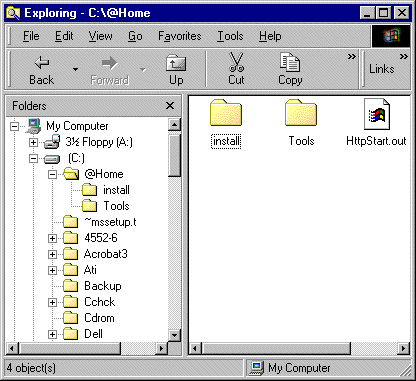
With the arrival of electronic communication, Nelson had seen an opportunity to move beyond many of the conventions of paper. After all, Why think about a “page” if the text can exist on a computer screen?
Nelson was also working to undo many of the conventions of the computer world — one of which was the emphasis on hierarchy as a design pattern. In place of hierarchy, Nelson posits that the world is actually deeply “intertwingled” — a word that he coined as part of his philosophy, and which I will explain later in one of the optional sections of this article. Before the web, Internet servers were (and still are) organized as hierarchical sets of folders, similar to what Windows and Mac users see when they browse their own hard drives. As anyone who has ever tried to locate a file in a deep hierarchy knows, the organization of hierarchical folders can be unintuitive, even arbitrary. As a demonstration of how abysmal hierarchy can be as an organizing principle, consider that it is often easier to find an internet document using google than it is to find a file on a corporate network that resides within a series of nested folders.7 This is because there are many different ways of organizing hierarchies; and figuring out each organization’s taxonomy can be challenging.
If hypertext links did not exist, readers on the internet would have to manually wade through hierarchical folders and load pages through documents, much as is done when accessing folders containing Microsoft Word documents. Imagine if the internet was made out of Microsoft Word or PDF documents that you could only traverse by manually typing in the URL. HTML provides a document format for the web that allows “pages” to be linked together, without all the “hierarchical hell” that computer users experience on their personal computers. Though at the fundamental level this hierarchy still exists, what Tim Berners-Lee did was to take Nelson’s invention and build a web of connections on top of an existing hierarchical foundation. We are left today with a way of connecting individual “pages” using fragile HTML links, whereas Nelson’s goal was to create unbreakable two-way links and eliminate both the hierarchical folders and the metaphor of paper.8
Ted’s parents divorced shortly after he was born; and he was raised by his mother’s very literate parents in New York, where Ted says his grandparents gave him an undergraduate education by the time he was 10.9 Nelson grew up reading the New Yorker and The Atlantic (*source*), imbuing in him an appreciation for literature. This appreciation for literature would inform the design of Xanadu®– the name Nelson gave his proposed repository for all the world’s past and future media.
Ted’s 3 Epiphanies
1. Nelson’s innovation was shaped by an unlikely combination of events, as well as three epiphanies. Nelson writes that the first epiphany came when he was very young — perhaps five years old. 10 Ted was in a rowboat with his grandparents when he paused to observe how the water was flowing around his hand as he trailed his hand in the water. Though many other boys his age have also trailed their hands in water, few have paused to think about all the individual atoms circulating around their fingers. Nelson experienced a moment of “awe”, at the amazing complexity of the world, where even just the smallest interaction between a boy’s hand and water is indescribably complex. Nelson would carry this concept of interconnected complexity with him and develop it further when he went to college.11
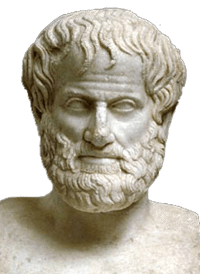
2. Nelson’s second epiphany occurred while in his
third year at Swarthmore College, writing a paper for his philosophy
class. Nelson concedes that the paper was
somewhat inspired and sweeping, but not fully baked
.
What made it so ambitious was how it broke from the influence of
Aristotelian philosophy.
Aristotle had divided the world into 10 kinds of things.
- Substance
- Quantity
- Quality
- Relation
- Place
- Time
- Being in Position
- Having (Condition)
- Doing
- Being Affected
Nelson objects to this strict categorization, arguing that the world is more properly understood through Heraclitus's idea of constant change. Heraclitus famously said:
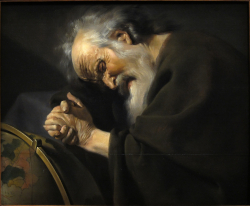
No man ever steps in the same river twice
.. meaning that the second time it is not the same river or the same man.
Nelson also objected to the idea that information could be classified into a single category. This seems obvious to computer users who "tag" their content with multiple tags rather than assign it to a single category, but at a fundamental level, most of our computer systems are based upon the foundation of forcing the real world into a set of hierarchical file folders.
Likewise, Nelson argues that in the real world, unlike paper, there may be no beginning and no end. Yet because of the linear conventions imposed upon us by the medium of paper, we divide information arbitrarily. (*source*)
Nelson would describe the writing of his 1958 Schematics paper12, at the age of 21, this way:
The experience of writing it was one of the most intense I have ever experienced, in an exalted state of excitement and inspiration. The same epiphany I had experienced at the age of five, of the immensity and indescribability of the world, came to me again, but this time with regard to realizing how models and language and thought worked, a way of approaching the great complexity I had envisioned long before.
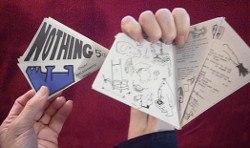
On his own initiative, Nelson would go on to complete a number of projects demonstrating his creativity, his versatility, and an unusual ability to conceptualize design in multiple spatial dimensions. While at Swarthmore, Ted created a kite-shaped magazine that had to be rotated to be read; 13 he wrote the world’s first rock musical; 14 and then in his senior year, Nelson directed a 33 minute film called “The epiphany of Slocum Furlow” in which he was able to visualize how the film would fit together when edited, a skill completely foreign to his fellow Swarthmore students. Though it is unclear whether he ever got college credit for all the projects he undertook, the experience of directing his own film gave Nelson the confidence that he had the innate talent to direct movies, a skill related to, but different from his father’s career in network television.
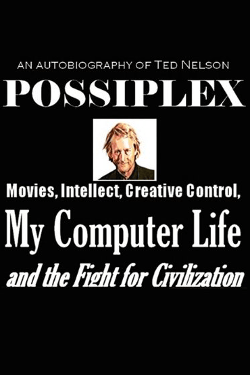
But by Nelson’s own admission: 15
My grades were fairly poor. I had gone for breadth, not depth, and I thought it was my own business to judge my achievement, not anybody else's. No one would care about my college grades in the afterlife of the so-called Real World. What mattered to me was studying what I chose, to the degree I chose, and pursuing the excitement of new ideas and projects.
How Ted was at the Right Place at the Right Time
What is remarkable then, is that despite Nelson's poor undergrad grades, one year later he would be admitted to Harvard Grad School, where he would work with computers in the fall of 1960.
After graduating, Ted met with Ralph (his father) in June of 1959 and was offered a job as an actor, although Ted felt that Ralph made the offer in such a critical way as to make Ted feel attacked. Ted turned Ralph’s offer down and was forced to find summer work on his own as a typist in a securities cage on Wall Street.

In the fall of 1959, Ted began his first year of grad school at the University of Chicago studying sociology. In “Possiplex”, Nelson recounts that the year was so awful:
I constantly felt my father’s curse like a sunlamp close to the back of my neck. I thought of suicide all the time, but I knew what that would do to my grandparents, and so I kept on.
Miller Analogies example
a. painting
b. composing
c. writing
d. orating
Chicago’s curriculum shunned theory, which was Nelson’s interest, so
he decided he needed to transfer somewhere else:
I took a test called the Miller Analogies, and, amazingly, that got me a fellowship to Harvard for the following year.
25
3. At Harvard, at the age of 23, Nelson took a course called “Computers for the Social Sciences”, where he says he experienced his third epiphany:
explosive moment came when I saw that you could hook graphical displays to computers. At once- over a few weeks- I saw that this would be the future of humanity: working at screens, able to read and write and publish from ever expanding new electronic repositories.
The world is not hierarchical; it’s intertwingled.
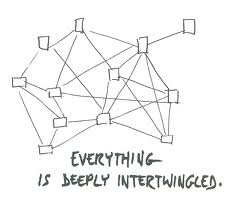
In 1960, Ted saw an opportunity to rethink the role of paper in media, because, for him, paper was an obstacle to expressing his thoughts. As Ted was composing a written piece he felt constrained by the paper because paper forced him to express himself in a linear pattern. Rather than writing from point A, to point B, Ted’s wanted to express all the related ideas that in linear writing are pruned away.
Unlike the pattern expressed in traditional paper-based writing, Nelson believes that ideas are not naturally organized as a linear narrative under a series of hierarchical headings or “folders”. Rather ideas are “intertwingled” and any description of a topic will follow a web of connections between related topics.
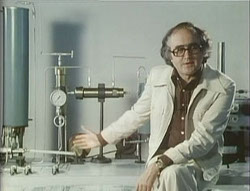
As James Burke demonstrated in his television series “Connections”, history is deeply intertwingled; and history students today learn diverse ways of approaching a subject. As an example of intertwingularity in Nelson’s Ph.D. thesis — “Philosophy of Hypertext” — Nelson cites the example of the “Battle of the Alamo”, listing 3 pages of interconnected items:
(If you’re reading this on the web, you can explore how hypertext enables the linked entities to assert their own connections. Links are almost expected now, but they were a foreign concept for many as recently as 20 years ago).
- The Battle of the Alamo was fought on 6 March 1836, by about 189 Americans defending a compound in San Antonio, Texas. All the defenders were massacred by a force of Mexican soldiers.
- The defenders of the Alamo are great heroes in American history, and included three famous men- William Barret Travis (who was in command), Davy Crockett (woodsman and former Congressman), and Jim Bowie (for whom the big Bowie knife was named).
- The Battle of the Alamo was possibly the pivotal event in the War of Texas Independence. By slowing down the movement of the Mexican army of cadets under Santa Anna, it gave the Texians time to prepare.
- San Jacinto was near the city which is now called Houston, in honor of the general who won the battle.
The song most people remember as “There was something in the air that night, the stars were bright, Fernando”– a Mexican folk song made popular most recently by the group ABBA– was from the Mexican side of that war.
- Davy Crockett, a folk hero in his own lifetime, became a folk hero again circa 1953 when the Disney movie “Davy Crockett” became a big hit, and millions of children wanted raccoon-skin hats.
- During a period of exile, Santa Anna stayed on Staten Island in New York with a photographer named Adams. Adams saw Santa Anna chewing chicle rubber, became interested in its commercial possibilities, and after several unsuccessful experiments created chewing gum, which was wildly successful.
Black Jack” chewing gum, created by Adams himself shortly after the Santa Anna stay, remained on sale for a hundred years.
- Emily Morgan is revered as a treasured heroine of the state of Texas for her legendary role in defeating Santa Anna. According to the story, on the eve of the battle, she seduced Santa Anna and next morning delayed his readiness- so that the battle for Texas independence was won with hardly a shot fired.
The song “Yellow Rose of Texas” is said to celebrate the achievement of Emily Morgan, who was “mulatto” (and thus, in the terminology of earlier days, “yellow”).
As you can see, these items don’t fit into a single paper-based linear narrative but flow in many directions. If you purchase a copy of “Philosophy of Hypertext”, you can also get the diagram Ted uses to conceptualize how items are connected.18 In my excerpt of them, I’ve been able to add HTML hyperlinks, but in a paper version, one would have to refer to each with a footnote.

The four walls of paper are like a prison because every idea wants to spring out in all directions
As Ted says, “paper is a prison” and footnotes are proof that the text wants to escape:
Footnotes are small initiatives to reach out of some arrangement of content, but they are extremely limited, like hands reaching out of jailhouse windows, constrained by a different plan.
Readers of David Foster Wallace are familiar with his use of footnotes to break out of the narrative.(*source*) He employed this device in his *classic* novel “Infinite Jest”, a novel with 396 endnotes, as well as a heavily footnoted piece he wrote for “The Atlantic” about the dynamics of the Talk radio industry.
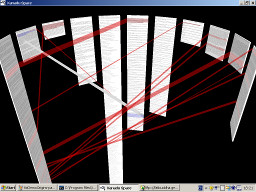
Whereas Berners-Lee based the world-wide-web upon a simplified version of SGML, with 1-way links (only going outwards), Nelson envisioned a richer version of hypertext without embedded markup:19
- Originally, all hypertext used 2-way links, meaning that the reader could see which pages link to the current document, not just view links going out from the current page. As the reader progresses through a document, the surrounding linked pages sworph (swoop and morph) into place, displaying the linked original text immediately to the right of the citing quote. This allows the reader to see the whole context of every idea, which is part of what “intertwingularity” is about. As an example, imagine that James Fallows wrote a series or “time capsules” chronicling moments where American politics moved into uncharted territory. Time Capsule #98 chronicles Donald Trump politicizing the classified briefings he received. Currently, I as a reader can view all the outgoing links that James Fallows chose. What Xanadu® would easily enable is the ability to view documents that cited Fallows' article. This would enable readers to see a whole other level of potential discussion. For articles with many citations, I imagine that browsers and search algorithms could be applied to filter the results.
- Documents change as corrections and alterations are made; and Nelson was searching for a way to make it easy to view and cite any version of a page
- As described above, Nelson wanted to be able to view the citing work in parallel with the original, so that he could see the context and inspect the quotation. On the web now, it is possible to open a new window, but on a long page, it can be difficult for the reader to manually find the quoted location and manually compare the citation to the original for context and accuracy.
- Nelson’s parallel design calls for a system which would retrieve and display the full text of cited documents, appearing to the right of the citing document, allowing the reader to see the exact context from which the quote was taken. This simple design element would have enormous implications for media because so much of discourse revolves around the proper meaning and usage of excerpts. (* IMAGE *)
-
With the arrival of computers, we lost something. Paper readers can annotate their own paper copy. Web readers cannot unless they print everything they read or copy the article contents into Google Docs, as I did to allow reviewers of this article to annotate it. Both Vannevar Bush and Nelson planned for hypertext readers to be able to make annotations and third-party links as easily as paper marginal notes. Bush envisioned note-takers sharing their links by hand and Nelson’s plan would have made annotation-sharing a major feature of the system. The web would be significantly different if anyone could share highlights and annotations of any page and the search engines/browsers could sift through annotations and return the best annotations in the same way they return the best pages. There are still plans for an annotation standard being made at the w3 consortium, but Berners-Lee’s decision to develop a quick-and-dirty design for the web has made universal annotations more difficult to implement. *source* *Get Image Permission**
- Ted said
I had my own copyright certificate
when he began his plans for his hypertext system and believed it essential that a hypertext system supports a way for authors to be automatically paid for both their original publication and its re-use by others. Because he foresaw the remixing of content, Nelson thought it important that the system pays authors on a metered per-character basis.
To the publishing industry, the idea of an internet with a built-in copyright meter must sound like a dream; but concern for copyright was built into Nelson’s original vision for Xanadu® from the beginning. Every letter of every word would be metered and a royalty would be instantly paid to the copyright holder.20 As of this writing, the articles I’m citing are not available in Xanadu® format, but if they were, Nelson has proposed that the price would be proportional to the price of a paperback book: If a book containing 80,000 words costs $16.00, a 100-word excerpt would cost $.02. This price would be paid, not by the writer making the excerpt, but by the reader whose computer receives a pointer to the cited text and downloads the actual original text.
If a series of writers quoted a series of sources, each writer’s readers would retrieve the cited original, compensating the source’s authors according to the amount of the original text each was responsible for.

Another important feature for Nelson was “versioning.” Nelson had thought about the publication process enough to think through many of the problem areas. One potential problem area occurs when a work links to a source that then changes.
Suppose I write my original version of an article that says that Ted Nelson was born in 1939. You quote my article and comment about it; and then I correct the figure to 1937. What should the reader see? On the web, your copy is uncorrected and the mistake propagates to anyone who quoted your article. With Xanadu the new version is available, but the old version is not overwritten, allowing the system to preserve a history of the article’s past.
Because Berners-Lee’s world-wide-web was not intended as a long-term archive of all knowledge, it does not provide a way of retaining information as server configurations change and links break. This has resulted in a problem for both readers and future historians, as every year approximately 5% of all pages disappear to “linkrot”.
In his “Philosophy of Hypertext”, Nelson talks about the concept of “substruction” — the process of finding unifying design patterns that bring together multiple goals to achieve a simpler design than would otherwise be possible if these goals were pursued independently.

As an example of substruction, he cites the example of the early computer game “Pac-Man”. Two goals of the design were to create a “maze game” and a “chase game”. The question that video game designer Toru Iwatani faced was how to fit these two goals into a single game. The concept he came up with was to create dots to be eaten, along with a special type of dot that allows the Pac-Man to switch modes and chase the ghosts. Starting from a blank slate, the way to unify the modes isn’t obvious, but in hindsight, the special dot seems like a natural, or obvious unifying design element. *source* 21
As he was designing his hypertext system, Nelson was committed to following good design, guided by heroes like Frank Lloyd Wright and Buckminster Fuller:
Following Bucky Fuller’s point of view, I believed that everything would be far better if only it could be redesigned completely.
What Nelson sought was a way to bring all these design goals together. An elegant way to:
- Link Documents together using 2-way links
- Keep track of different versions
- Track copyright usage
- Support annotations and third-party links as easily as paper marginal notes
- Display quoted information side by side
Ted developed the basic design for hypertext using a technique he called “transclusion”. Transclusion is a way of including content from another document or source without making a copy. In HTML it is possible to transclude an image from another website by entering its address in the source attribute:
This is the code to transclude the Pac man image listed above:
<img src="https://simple.wikipedia.org/wiki/File:Pac_Man.svg" />
It is also possible to transclude entire youtube videos using the "embedding" feature: (This is the ABBA video listed above)
<iframe width="560" height="315" src="https://www.youtube.com/embed/jHYn7LHV7fg" frameborder="0" allowfullscreen> </iframe>
A full hypertext system like Xanadu would make it possible to embed text (all types of content, really) so that the content of a citation comes from an original source rather than a copy.22 This would allow an author to quote part of a document on the internet and have the content pulled from the original. The link between the citing document and the source is permanently recorded and the author of the cited document is paid whenever readers access the citing document. Equally important, the connection between the citation and the original is permanently made, allowing the web browser to display the connection between the source and citation. Web techies may compare it to “hotlinking”, but the author is paid and the system takes care of the hosting.
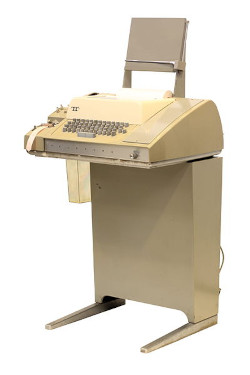
As Paul Saffo described in the introductory video, Ted spent years in the “wilderness” advocating for a universal hypertext system and facing the type of obstacles that sound archaic today, given our current software ecosystem. As Ted recounts in “Possiplex”, it was much more difficult to make progress building software in the 1960s and 1970s. In 1971, Ted got the backing of an investor to rent a computer for the development of the “Jot” editor. Programmed on a 33 ASR Teletype and a cassette drive, collaborators Cal Daniels, John Ridgway, and Harry Mendell developed a text editor that created documents with permanent content in a “append-only” writing mode, where all changes were made by adding to the end of the file, rather than updating or deleting what had previously been entered. (Possiplex 193) This approach was advantageous because it avoided the need to rewind the cassette tape while making changes. Nelson tried to get his investor to buy the computer for $10,000 rather than rent it, but to no avail. They returned the machine before their design could be tested. Unfortunately, their program only ran on the same type of computer as they had rented because popular operating systems like Windows did not exist to bridge incompatibilities between different hardware.
It should also be added that one of Ted's major disadvantages in developing Xanadu was that he was not a programmer. Ted has said that not learning how to program is one of his major regrets, as he had to rely on others to implement designs. (Intertwingled Conference Speech: 41 min)
In the 1960s, Nelson widely underestimated the work required to created Xanadu, thinking that it would only take 2 years to create the system and then he would retire from the computer field and direct movies.
Xanadu® gets Commercial Backing
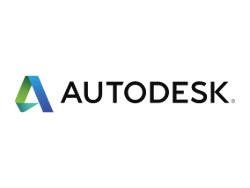
It took *decades* of labor with various programmers, most notably Roger Gregory, who headed the project up until 1988, when Ted made what he regards to be his biggest mistake.(*source) Nelson had gone without financing for Project Xanadu® for the entire time (decades) until 1988, when Autodesk (makers of AutoCAD) decided to finance an effort to commercialize Ted’s Xanadu® system. Papers were signed and a team was formed with the goal of finishing a codebase largely written by Roger Gregory.
I was told on the phone — I forget by whom — that my good friend Roger Gregory, who was in charge at XOC down south in Palo Alto, was throwing things and acting crazy. I heard that ‘everybody was ready to leave,’ possibly quit within a day or so.
What Nelson failed to realize was that Roger was upset because the other programmers wanted to scrap all the existing code and start from scratch with a new programming language and design.23 Roger’s goal had been to finish off the existing code base and publish within a year. The decision to start again from scratch would put them in an untenable position four years later, when the revised project was still incomplete; and Autodesk cut funding to Xanadu® after Autodesk ran into financial trouble.
Tim Berners-Lee and the Web
Ted Nelson recalls meeting with Tim Berners-Lee a few years later (*fact check*) about Berners-Lee’s proposal for the world-wide-web:
Tim Berners-Lee came and we had lunch, in, oh I guess it was 1989, 90, something like that, in Sausalito, and I really liked the guy, and he’d done this very simple thing, and it sounded too trivial to me {laughs} but he certainly was a nice fellow and I expected to keep in touch with him, although I am a very bad correspondent, and the next thing I knew suddenly the thing had caught on.
Berners-Lee’s system had none of the advanced features that Ted believed were essential for a hypertext system. What’s more, it imitated “paper under glass” (*source*).24 There was no ability to take marginal notes. There was no version control. You could only follow links in one direction. And you could not compare documents side by side. Finally, there was no copyright mechanism to compensate authors.
There’s a history of ambitious, thoughtful technical projects losing out to simpler, corner-cutting designs. In the winter of 1991-92, Richard P. Gabriel published a controversial article that captures some of the tradeoffs that are involved in making software. The article, titled “The Rise of Worse Is Better”, described two systems, dubbed “The Right Thing” and “Worse is better.” In the article, Gabriel argues that “The Right Thing” is often complex and difficult to create, making a system that sacrifices correctness for ease of implementation more successful in the marketplace. Though Gabriel later wrote a follow-up article recanting the original, many people still have the impression that it is better to make design compromises to ensure that the product gets an early foothold in the marketplace.
Ted's proposed hypertext system had a series of advanced features like:
- versioning
- 2-way links
- copyright metering
- support for annotations
- support for parallelism: displaying multiple documents side-by-side
Had Nelson known that people weren’t willing to wait for his complete system, he would have been prepared to make compromises (*source*) 23x that still would have preserved a lot of potential functionality, but he didn’t imagine a hypertext system like Berners-Lee’s web would be successful without the more sophisticated features.
The Legacy of Xerox-PARC
Another way of looking at design influences is to consider the influence of the PARC lab on the development of computing. Xerox PARC is a research and development lab started by the Xerox Corporation, which pioneered the development of:
- Graphical user interfaces (GUI): with icons and a mouse, 16
- Laser printers,
- Ethernet (networking), and
- WYSIWYG text editing, among others.26
It is the graphical user interface and the WYSIWYG text editor that Nelson especially objects to because the development by Xerox PARC, and later adoption by Apple and Microsoft *laid the foundation* of our paper simulation paradigm.
Xerox’s research and development office was not a disinterested group of
people searching about for the strictly best way to organize information;
they were owned by a company that made money printing things on paper.
As Nelson likes to say
Xerox was a paper-walloping company
.
The whole point of WYSIWYG is not to represent reality: “What You See Is What You Get” is the slogan, but the unstated assumption is “What You See Is What You Get when you PRINT IT OUT!” (*source*)
Xerox PARC developed an initial implementation of the GUI that they demonstrated to Steve Jobs of Apple. There’s an interesting story told in Walter Isaacson’s book about Steve Jobs in which Jobs summons Bill Gates down to Apple’s offices in Cupertino to receive a *tongue lashing*:
Their meeting was in Jobs’s conference room, where Gates found himself surrounded by ten Apple employees who were eager to watch their boss assail him. Jobs didn’t disappoint his troops. “You’re ripping us off!” he shouted. “I trusted you, and now you’re stealing from us!” Gates just sat there coolly, looking Steve in the eye, before hurling back, in his squeaky voice, what became a classic zinger. “Well, Steve, I think there’s more than one way of looking at it. I think it’s more like we both had this rich neighbor named Xerox and I broke into his house to steal the TV set and found out that you had already stolen it.

Twitter’s decision to limit their messages to 140 characters is more as a result of an arbitrary legacy design than the influence of research funders’ business interests. That’s because Twitter’s 140 character limit was devised when traffic happened over the telephone SMS system, which had a 160-character limit. Twitter didn’t want to have to break their tweets into multiple SMS messages, so they allowed for a 20 character username field and 140 characters were what remained.
Recently, Twitter has talked about making changes to that limit. In May, they announced that they will stop counting photos and links as part of that limit, which should make the system friendlier to marketers. Upon inspection, it becomes apparent that much of the “architecture” we assume to be a “natural” part of computerization has been influenced by either arbitrary technical considerations, bad philosophy,27 or business interests.
A Philosophy of Media
When Ted was a grad student at Harvard, the conventional wisdom was that computers were just tabulation devices, tools to automate calculations; but when Ted saw his first computer screen, he realized that “they had been lying” (*source*) — the potential of computers is so much greater than mere calculators.
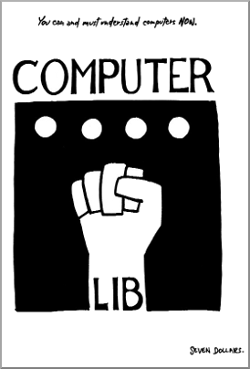
Already in 1974, Nelson presciently argued in “Computer Lib: You Can and Must Understand Computers Now” that computers were for everyone (not just big businesses) and that the design of computers is a political act that is too important to be left to the techies. Nelson further saw that the book could be redefined in a digital era and that authors could be freed to write something beyond the confines of linear containers like today’s Microsoft Word or the e-book.
The vast majority of people using the world wide web consider its imitation of paper to be a success; and even if it is not the theoretically “Best” approach, they can’t imagine a viable alternative; yet for years the movie industry has used systems that have similarities to Nelson’s Xanadu® design. The basic idea is to make references to content rather than copies. In the movie industry, the generic term for this system is called EDL – edit decision list.
What this means for movies is that the producer is given a tool that allows them to make a listing of clips to be included in the final movie. Rather than immediately making copies of those clips, the system stores the time offsets from each clip, allowing the producer to experiment with different edits, all while pulling the video from the original sources. When the video is to be viewed, the EDL is consulted and the video is constructed from its individual component clips. In this way, the original sources and all the instructions about how to assemble the film from the originals are retained. 28
By contrast, when a quotation is shown on television or in print, the quoting author makes a copy of the original and doesn't provide any instructions on how the clip fits within the original, making it difficult (or at least inconvenient for) the reader to gather the fuller perspective.
Nelson envisions Xanadu® allowing authors to transclude content – embedding text and multimedia from across the internet and combine them in a way so that all the citations to the original sources remain intact and all connections are made visible. Because the system proposes an automatic rights management system, the author doesn’t need to track down the copyright holders. All copyright holders are paid because the viewer’s computer follows links to the original and pays the original creator as they download the original.

This means that embedding could move beyond just the basic form of embedding a YouTube video in a web page, as I did at the opening of this piece with the Paul Saffo video. Instead, in Nelson’s system, I could embed text from other documents in my own document, but the system would maintain a record of those links, allowing all readers to view the original sources, and showing the context from which they were taken. I could also grab clips of videos from all around the web and incorporate them in one of my own videos. The links back to the original videos would be preserved; and readers could trace the context of the clips, much as they can view the context of the textual quotations in this piece.
So much of the practice of *video reporting* revolves around the decisions of the creators or producers of a piece about where to make a cut. In politics, much of the effort is made to find a short clip that can be excerpted into a news story. Voters would be able to better contextualize the stories if they could view prior events.
Trevor Noah of the “Daily Show” shows 2 stories from the Presidential Campaign that rely on poorly-sourced quotations.
Imagine how radically different things would be if every content producer could source and publish their material in such a way that the viewer could pause the video and rewind past the clip’s starting point. Viewers would then see the content before the cut was made. Such a system is possible, and it is part of the vision Nelson advocates.

The Issue of Address Granularity
Nelson envisioned Xanadu allowing the compilation of content from around the internet — remixing on a grand scale — all made possible for text, and video because each letter of each word and each video frame has its own "granular" address, whereas on the web the only types of content that have their own addresses are pages (the entire page), and files.
Postal Addresses
If you look at the physical world, the standardization of American postal addresses happened much more recently than many people think.
It’s only within the last decade that every house has a street address,” says Nancy Pope, a historian at the Smithsonian National Postal Museum.
The Atlantic ran a story about a British company called What3Words that that aims to solve this problem of granular physical addressing on a global scale. Not all roads in all countries are named; and not all named roads have street numbers. What3words aims to solve this problem by identifying all addresses on earth to within 3 meters using only a combination of 3 words. For example, The White House’s w3w address is: live.linen.slower.
Using only 3 words, citizens of Mongolia could send a letter to a recipient in another part of the country, even though that recipient does not have a numbered address on a named street.
Tumbler Example
could be similarly numbered,
so that Chapter Five in Volume Three
would be represented as 3.5.
This could be extended arbitrarily,
so that 3.5.10.6 represents
Volume Three, Chapter Five,
Section Ten, Paragraph Six.
Like the United State’s early postal system’s coarse addressing system, our current web URLs lack a granularity that would allow us to permanently refer to an arbitrary location within a web page. This hampers our ability to build systems that remix and annotate content. By using an addressing system called “Tumblers”, Nelson’s system is able to keep track of different versions, as well as allow any selection of text or multimedia to be cited at a granular level.
I’ve been discussing the big-picture, but if you dig into the technical details available in Ted’s book “Literary Machines”, you can see how, as with the Pac-Man design, Xanadu® aims to achieve multiple design goals through substruction.
What is the Benefit of Good Media?
An early reader of a draft of this article still wasn’t clear about exactly how Xanadu® would make his life better. It’s hard to appreciate the transformative impact of some concepts unless you experience them yourself.
Visualizing "Connectivity"
Bret Victor’s 2012 speech to the Canadian University Software Engineering Conference provides an illustration of the benefits of systems that increase "connectivity" by eliminating the need for creators to be able to visualize so much in their heads. Victor gives examples of how great tools can make a difference for computer programmers, animators, and electrical engineers by providing real-time feedback and eliminating the gap in the act -> test feedback cycle.
Better Conceptualizing Numbers
One way of thinking about Xanadu® is that the connectivity it allows is like the adoption of Arabic numbers in place of Roman numerals. Roman numerals were widely used up until the middle ages, despite the difficulty they pose for tasks like multiplication.
Multiplication using roman numerals is not particularly easy or obvious. You can do the trivial thing, which is repeated addition. But it should be pretty obvious that that's not practical for large numbers.
It was only with the introduction of the Hindi-Arabic numbers that large-scale multiplication tasks could be easily undertaken.
The task for our present media is not representing numbers in a way that makes multiplication easier, but representing text, audio, and video in a way that allows the reader to view the full context without leaving the medium's “present” to consult some additional source.The fact that authors and video creators do not have a medium which allows the reader/viewer to access the full context of a text or video forces creators to make choices, often abbreviating the citation for sake of brevity or "punch".
Alternately, it gives the creator/editor the option to spin a situation in an advantageous way, knowing that the audience will react in a preferred way to a clip removed from further context.
In Computer Lib, Ted Talked about computers as "Thinker Toys" because they would allow computer users to engage in more complicated thought, much as Arabic numbers allows merchants to more easily multiply large numbers.
Sometimes when I talk to people about these potential benefits of an advanced hypertext system like Xanadu®, they impose what I consider to be unrealistic expectations on it. It is true that the majority of web surfers will not use Xanadu’s® advanced features as authors. Asking most people to write a blog is too much, so for many people, shallow tools like Facebook and Twitter are sufficient. But we live in a world with immense talent, where the majority of all quality content is created by a minority of people. What we need is not a huge number of authors, but better tools for those authors with something to say. What we need is a way to financially support the creative people we do have, or more optimistically, all those authors we could have were the economics viable.
Wired Magazine's 1995 Article
In June of 1995, Wired magazine ran a story titled “The Curse of Xanadu” that deeply wounded Nelson and set back his project. The author, Gary Wolf, 30 called Xanadu
longest-running vaporware project in the history of computing – a 30-year saga of rabid prototyping and heart-slashing despair.
.. and portrayed Nelson and his lead programmer as inept and crazy. The article’s main substantive critiques were that:
- They over-promised and under-delivered.
- The task of publishing all the world’s knowledge was not possible with that era’s hardware.
- They were arrogant to think they could build a computer system which wouldn’t grow obsolete.
- The creation of a front-end was too important to be left as an afterthought.
- The system couldn’t scale.
Tim Bray, (co-author of the XML spec), says:
I disagree with virtually every technical argument Ted Nelson has ever made and (in most cases) the implementations are on my side, but it doesn't matter; Ted's place in history is secure because he asked more important questions than just about anybody. I think he usually offered the wrong answers, but questions are more important.
I asked Ian Davis, one of my college professors at the University of Waterloo, who worked with Bray on the digitization of the Oxford English Dictionary (OED) about the issues they had in digitizing the dictionary and Davis said that it is a lot more work maintaining markup as a separate file, instead of embedding it, as HTML does:
If you store the markup separately then one has to reconstitute the HTML whenever it needs presentation. This is quite complex since there are lots of nuances regarding things like comments, spacing, and presence and absence of markup which must then be handled. It also makes it quite difficult to reconstruct from the fragments a document potentially not even conforming to XML originally — documents do often contain errors in their construction.
.. The source code I wrote is still available. It is about 100,000 lines of code
For those technically inclined, as a comparison between the Embedded Model, which the web uses, and a Non-Embedded Model, which Ted Nelson advocates, consider the following example:
Embedded: (HTML: 2 levels)
A1) car.html
<p>The car is available in two colors:</p>
<ol>
<li id="red">red</li>
<li><span id="blue">blue</span></li>
</ol>A2) car.css
#red { color : 'red'}
span#blue { color: 'blue'}Non-Embedded: 3 levels
B1) car.txt
The car is available in two colors:
* red
* blueB2) car.stucture (pseudo code)
p[1,1:1:36]
li[2,5:2:8]
li[3,5:3:9]
#red[2,5:2:8]
#blue[3,5:3:9]
B3) car.presentation (pseudo code)
#red { color : 'red'}
#blue { color: 'blue'}An Opposing View: Doug Merritt
Doug Merritt says Nelson's design was not impossible, but that its implementation was bungled by a lack of professionalism:
The problem wasn't time, it was a combination of things that add up to unprofessionalism: AnalysisParalysis, bad project management, chronic underfunding most (but not all) of the time, in-fighting, and worst of all, they actually finished it a bunch of times! Back when Autodesk was funding them. But they took a perfectionist attitude, and always decided to rewrite the code from scratch every time they finished something that worked even a little bit, rather than release it. I was at AutoDesk at the time and saw working code demoed. A whip-cracking no-nonsense project manager would have changed the history of Xanadu single-handedly (if humanly possible, given the HerdingCatsProblem)

Nelson writes that the effect of the Wired article was that:
we had no access to respect or funding, even in the dot-com feeding frenzy that was underway; and above all to deny us any credit for the thinking behind the World Wide Web.
After Wolf’s *condemning* article, Nelson went to Japan, where he still had many admirers, and wrote a Ph.D. thesis at Keio University. The thesis is dated January 10, 2002. A few years ago I sought out a copy through the interlibrary system; and I found that Japanese academic standards are different than American, making the thesis a private document, rather than a public one. Nelson shared a copy of the thesis with me privately, but it was not until this year (January 2017) that the thesis became publicly available.

Motivation for Hypertext
Finally, other than blaming Nelson for the failure at AutoDesk,
one interesting theory Wolf floats in the Wired article is the idea
that Nelson’s motivation for creating Xanadu® was his atypical cognitive style,
31
citing what Nelson calls his hummingbird mind
:
His great inspiration was to imagine a computer program that could keep track of all the divergent paths of his thinking and writing. To this concept of branching, nonlinear writing, Nelson gave the name hypertext.
One key feature of Xanadu® is that you must be able to see more than a single page at a time. The world wide web of the Andreessen browser allows only a single page to be open at once. Sure you can open multiple tabs, but as you switch between tabs, the previously open tab disappears. You can open multiple windows, but for longer documents, the visible connection to the original is lost, making it difficult to locate the context within the cited document where a quotation was sourced. It is possible, but it is like multiplying Roman numerals — a task that is possible, but infrequently attempted because of its practicality.
Ted argues, and I agree, that being able to browse a single document, while at the same time having the contextual citations appear automatical to the right (in parallel) would have a transformative effect on readers; and creators would be rewarded for providing an "expanded expressiveness" that cites sources rather than wallowing in 140-character Twitter-like catchiness.
A second major benefit of Xanadu® would be the ability to remix content while compensating the creators. Our current advertising-supported web culture has resulted in a competition for advertising eyeballs that leads to a "clickbait culture", where content creators compete to attract the most clickthroughs. Because the content is “free”, the content is “cheap”. A system with “micropayments” (a word coined by Nelson) would support a broader class of creative professionals, rather than the hollowing-out that has happened instead. In fact, Nelson envisioned a whole new class of creative people whose work would be supported by micropayments. (*source*)
A third benefit of Xanadu® would come from new uses of information made possible by Xanadu’s® granular addressing system. Much as GPS transforms activities from farming, to travel, to geotagging photographs, a granular address system like Xanadu’s® would allow:
- People to fact-check documents, by annotating a specific sentence, phrase, or number in an article.
- Search engines to find the best “pro” and “con” arguments that reference a particular line in an essay. Right now authors can cite or write a counter argument for a particular page, but granular addressing would allow authors to highlight a particular word and make a comment or post. This sort of advance has been attempted on a small scale on sites like Medium.com and Quartz, but Xanadu would enable this sort of commenting on all documents. Making all comments easily available to developers in a structured way would allow developers to compete to the create the best interface for filtering and displaying comments, much like the accessibility of HTML allowed programmers at Alta Vista, Yahoo, Bing, and Google to create a competitive market for search engines. This competitive market for filtering content is what has made the web successful. More granular addressing would create expanded markets for good content.
- Video creators could also easily grab a few seconds of a video while crediting the original, and allowing their readers to compensate all the creators and see the original context. Reduced friction in the acquisition and compensation of original content would benefit both creators and readers.
What do Xanadu® demos look like?
Xanadu® has never been widely deployed to a public network, but there are demonstrations that run on a single computer. As a demo of what his looks like, consider Ted’s demonstration of how “Origins”, a piece by Moe Juste, interacts with several sources:
Getting Web Browsers like Chrome or Internet Explorer to support viewing multiple sources in parallel is a major challenge. Nelson has continued work on his vision and his goal is to release his own editor and browser (called Possiplex). But since Nelson is not a programmer,32 he is limited by the supply of programmers who collaborate with him.32 As one demonstration of what Xanadu® could look like, one programmer, Nicholas Levin, was able to make a demo work within the constraints of the browser. One should note that though it loads slowly it does allow the reader to experience what it is like to view multiple texts in parallel. Ted’s vision was to develop the right backend design and allow programmers to develop multiple front-end browsers. The usability of these two prototypes would likely be improved, just as the competition among Netscape, Internet Explorer, Firefox, Chrome, Opera, and Safari has made old editions of these software programs seem antique.
An Example of Parallel Documents (Optional)
For a demonstration of the benefits of parallel documents, consider a short article I put together about how the way Jesus read his “Bible” angered his contemporaries (Isaiah 61) and almost ended his ministry on the very first day.
Maciej Cegłowski writes that the history of airplanes has been one of modest improvements in spite of grand visions of the “planes of tomorrow”. Cegłowski describes the lofty plans for planes like the Boeing 2707, a plane that was designed to transport 250-300 passengers at Mach 3. Decades later, we have no 2707 and are still serviced by the 747, the plane that was intended to buy Boeing time to release the 2707 in the 1970s. Why? Part of the reason why we still have the 747 is that the public does not want to deal with sonic booms as aircraft fly overhead. Noise inside the cabin is a factor, as a concern for the ozone layer. There are definite physical limits that constrain the market for aircraft.
Cegłowski also writes that the time taken by traveling from Switzerland to San Francisco (11 hours) is considered manageable; and people don’t think it worthwhile to reduce this.
It took eleven hours and cost me around a thousand dollars. It was a long flight and kind of uncomfortable and boring. But I crossed the planet in half a day! Being able to get anywhere in the world in a day is really good enough. We complain about air travel but consider that for a couple of thousand dollars, you can go anywhere, overnight.
Is Hypertext “Good Enough”?
Is hypertext like airplanes — destined for only modest improvements because it is already “good enough” — or is Ted Nelson’s unfulfilled vision still of value? Will the hypertext of 2060 be a slightly tweaked version of what we have today? To answer that question, consider whether the constraints on hypertext are physical and resource limitations, or conceptual? Alternatively consider the question – how much does media matter?
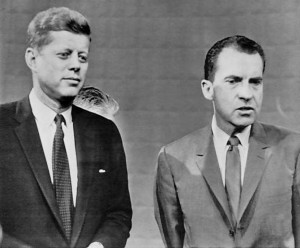
Media theorists know that Marshall McLuhan said “The medium is the message”, meaning that the way a message is conveyed shapes how the message is experienced. (*source*) Famously, radio listeners thought that Nixon won the 1960 debate, while television viewers thought Kennedy had won.
Our current media landscape lends itself well to a political candidate who is adept at using 140 character tweets and provoking free media time, which can then circulate via Facebook. This is our generation’s version of the “Fireside chat”. Today, topics which can be covered in a short catchy video may be critiqued, but it can be difficult to address subjects which require the evaluation of context, or more than 2 minutes of extended reading — hence the dominance of the overly simple solution to complex problems.
As Andrew McGill wrote in The Atlantic:
This is the fundamental difference in how the two presumptive nominees approach challenges. Trump tends to focus on what he identifies as the problem—how America has been wronged and who is to blame. Jobs went overseas? End NAFTA. Worried about terror? Ban Muslims. The solution is usually simple: Just stop doing whatever the U.S. was doing before. The community will prosper.
Yet if McLuhan is right and the types of political candidates we field is influenced so much by our media, it seems worthwhile to devote the resources necessary to design “more perfect” media.
Hypertext Faces Metcalfe’s Law
Given the scale of companies like Amazon.com, Google, and Facebook, the resources required to design an improved alternate version of hypertext are available, but the market for any such system is constrained by the network effects described by Metcalfe’s Law.

Metcalfe’s Law states that the value of a network is proportional to the square of its connections. As an example, suppose that an inventor invented a new type of telephone that had clearer sound quality and required less energy than existing phones, but only ran on its own network. If this network had an existing install base of two users, the value of the connections would be 4. (*phrasing* *fact-check*)
A network of 5 users would have 25 different possible connections. A network of 1000 users has 1 million possible connections. From this simple math, we can see that network effects make large existing networks deeply resistant to competition unless the competitor networks are cross-compatible.
How many people would value an improved phone enough to switch to a system on which many of their friends and family were inaccessible? The value of the enhancements is more than offset by the loss of access to the existing network, just as the value of an alternative hypertext system would be limited if it lacked interoperability with the old.
My visit to see Ted this September / What could Ted Nelson learn from Tesla?
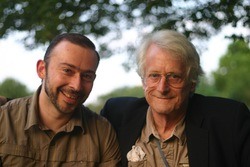
with Ted Nelson at Nelson's family farm in New Jersey
When I paid a visit to Ted and his new wife Lauren Sarno this past September, the purpose of my visit was partly to experience meeting the person who played such a significant role in the shaping of our present media landscape, but also to talk with both Ted and Lauren about plans for the launch of Ted's Ph.D. thesis this January.
I found Ted charming, engaging, and very sharp, despite his 79 years; but while Ted talked freely about his ideas, he took little interest in strategy or business details, saying "I'm not a businessman".
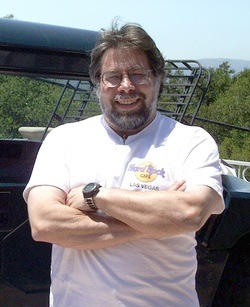
I had been talking to Ted about who he thought might be a good early adopter of Xanadu. My thinking was that academia might offer an audience that valued Xanadu's more sophisticated citation system; and many Universities are currently questioning the high price tag and durability of the existing electronic journals.
It's probably too much to ask any one person to fill all the hats in a company —
visionary, programmer, marketer, and businessperson. Steve Jobs had
Steve Wozniak who single-handedly created that Apple I
.
Ted never had that type of partnership (footnote:
"Two Cheers for Now"
(28:50)); but as I talked to Ted and Lauren, I did get a sense that Lauren was bringing
something important to the marriage. Ted's beloved wife Maureen passed away in May of 2015. This past June, Ted married Lauren Sarno, who first got to know
Ted when she was 14 years old (*fact check*) and part of the
R.E.S.I.S.T.O.R.S. —
one of the first computer clubs for young people. In addition to her long history with Ted,
Lauren brings with her 20 years working in marketing and a
talent for "getting things done".
What could Ted Nelson learn from Tesla?

Later as I was thinking about what sort of marketing strategy Xanadu should take, I was reminded how Tesla built themselves a market for electric cars. Several years ago, if you had the idea of starting a company to sell electric cars, you would have faced a problem of a marketing strategy — first, it's hard to produce an electric car that can go for more than 30 miles on a charge; and the cars are very expensive. How are you going to establish a customer base if the car costs $70,000 and has such a limited range? Simple, once you've identified a target market. Tesla marketed the vehicles to a group of early adopters as sports cars with an acceleration from 0-60 in under 3 seconds!
After they proved themselves in the prestigious sports-car category and they had improved their cost-efficiency, they announced pre-sales of the $35,000 Model 3. Prospective buyers put down $1,000 deposits allowing Tesla to gauge the public's enthusiasm for the car. This also allows Tesla to get bulk discounts from suppliers and gives Tesla a free $10 billion loan from customers. Xanadu needs to apply the same type of marketing insight to determine how to position itself.
One place where experimentation could be done is in the market for e-books and apps. As mentioned earlier in this piece, creators are looking beyond the web for a medium that makes it easy to charge for their content, but the disadvantage of this is that authors can’t link deeply into other author’s e-books or apps. Meanwhile, the prevailing web model is hardly sustainable, requiring readers to sign up with every paid site they visit.

What the publishing world needs is a system — like iTunes — that reduces the friction for creators to charge for their content, and that doesn't require every author to use their own checkout and payment platforms, while at the same time remaining permeable to linking and remixing.
What is needed is a means of connecting these unlinked spaces together — a medium where creators can both get paid and get connected. This is an area where there is still a potential opening for a system like Xanadu.
Promoting the value of an Alternate System
The inertia of our present hypertext system is very high; and the argument for an alternate system has not been popularized enough to support an alternative market; so as a small demonstration of the potential value of fully-contextual documents, I’ve created some simple interim computer code that suggests some of the power of a more contextual document format, without requiring browsers to support viewing of multiple documents in parallel.
CiteIt WebsiteI call the technique of dynamically displaying the context surrounding a quotation “CiteIt”; and I’ve created the CiteIt javascript plugin for use throughout this article to demonstrate the context of quotations. If you click on one of the red arrows above or below a quote, the immediate context of the quote appears. This context is looked up at the time the piece is written, stored in a JSON file on the Amazon S3 Cloud, and injected into the document by my javascript library.
Unlike Xanadu®, CiteIt currently does not feature parallelism,33 but for phones and other small screens, there is not enough screen real-estate to display quotations with parallelism anyway.
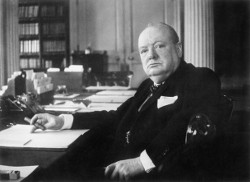
If at some point an effort is made for a Xanadu-like system, a quote apocryphally attributed to Winston Churchill will be fulfilled:
[They] will always do the right thing… after they’ve exhausted all the alternatives.
My hope for CiteIt is that it demonstrates the value of contextual quotation and serves as an impetus for the development of more advanced user interfaces that will eventually expand to feature full parallelism.
When we look at our media landscape, there is a tendency to see our current systems as "natural", or fixed; but by looking back at history we see that the technology we take for granted followed a path that could have been different. Ted Nelson's philosophy spurred him to develop a system that rejected the conventions of hierarchy and paper. The task of designing a new hypertext system was more difficult than he anticipated and his Xanadu system was "disrupted" by the web, which compromised on a simpler one-page-at-a-time paper-emulating paradigm.
Ted Nelson was the first person to foresee a world fully-connected by hypertext, but he has not yet been able to describe it sufficiently, or to implement his ideas as software. For years, people have scoffed at him because his dreams were both difficult to understand and beyond his capabilities to implement. (footnote: he is not a programmer)
Now at age 79, Ted is still pursuing his vision but with volunteer programmers because he lacks a source of funding. This January, Nelson is releasing his most full description of Xanadu, his 2002 Ph.D. thesis, Intertwingled, written at Keio University in Japan. Technical people will find write-ups filling several hundreds of pages of appendices. Historians and philosophers will find supporting documents describing the development of Ted's philosophy. The non-technical reader might do best by starting with Ted's autobiography — Possiplex — which was published in 2011.

I'll conclude with one final thought about the state of our media — Ours is a time when the talk in Silicon Valley swirls around the ideal of progressive “disruption” and big dreams. Uber wants to disrupt the taxi industry. Google wants to disrupt the auto industry. Larry Page is investing $100 million in self-driving flying cars; and people talk about spending trillions to go to Mars. Everyone in the technology sector is looking for non-technical industries to “disrupt” at an enormous scale; but the question I pose concerns Silicon Valley's home turf — “Can anyone disrupt the web? Or is the web the one technology that is beyond disruption?”
Ted Nelson's ambition is not so high as to entirely replace the web. Instead, at the end of "Philosophy of Hypertext" he says:
The important question is whether these ideas can enable a principled and feasible alternative universe, beneficial even if implemented only in part, a potential zone of clarity in the chaos of the Web, desirable enough to be worth the uphill effort.
Would it mean just too much overhead? We believe that like the hidden overhead of the Internet itself, such a structure will pay for itself manyfold. We can see no other important agenda for hypertext.
More Information:
Ted Nelson has received little recognition and no royalties for his contributions to the internet. He is now 79 years-old; and purchases of his self-published books will help fund his continuing work and retirement.
View Ted Nelson’s Home Page CiteIt project CiteIt on GithubP.S. What do you think about our media?
What do you think about the idea of an alternate media system?
The is not agreement about where exactly Ted saw the computer monitors because monitors were very rare in 1960. See presentation by media historian Belinda Barnet, “What we might yet be: the importance of Ted’s vision”: 4:10 p.m. at Chapman University Conference: “Intertwingled”↩
Ted doesn't like the term "hyperlink" because it implies a simplistic form of hypertext where the reader has to "leave" the source page to "visit" the destination. He believes that the original page should not disappear, and that the desitination page should be loaded beside the original.
For more on ideas that predated the web: Alex Wright’s Google Tech Talk: The web that wasn’t (59 min)↩
Google tracks what results searchers click on, allowing future searchers to benefit from the search refinements past searchers have “blazed”.↩
See Ted Nelson's book "Geeks Bearing Gifts: How the computer world got this way", pages 76-78.
For a look at the first website visit the CERN “birth of the web website”.↩
Get input from Ted↩
In an alternate hypertext system, you could annotate this section, perhaps leaving a comment tied to specific text or saying “Amen!” if you agreed. The search engine/clients would aggregate other “readers” responses and show you the most highly rated comments of this fragment of text.↩
One could correctly quibble that the DNS system that is the foundation of the URL is also hierarchical.↩
Youtube video, Ted Nelson interview by Gardner Campbell, Virginia Commonwealth University (13 min)↩
Ted’s favorite Greek philosopher is Heraclitus, who said “No man ever steps in the same river twice, for it’s not the same river and he’s not the same man.”↩
One of the special things about Ted’s Ph.D. thesis, “Philosophy of Hypertext”, is that it includes an extended writeup of the Schematics paper, as well as a scan of the original↩
Possiplex, page 71: See Photo | Excerpt: Chapter 4, 1957: A Kite-Shaped Nothing↩
This is even more remarkable when you read that Ted dropped out of school in grade 7? (*source*). ↩
View the first video in this article: Paul Saffo Interview at Ted Nelson Possiplex Book Launch at the Internet Archive.↩
Philosophy of Hypertext, page 18, 21↩
In html, if I wanted to bold a word, I would surround the word ‘bold’ with the <b> tag.
Nelson would move the formatting tags to a (usually) separate file, much like css is separate from the html. This would make transclusion and annotation easier.↩This would be a one-time fee, a purchase, not a pay-per view↩
*Needs to cite Philosophy of Hypertext page number↩
HTML supports transclusion of images, but not text. In HTML, a remote image can be transcluded by specifying the source’s URL:
<img src="http://xanadu.com.au/ted/tednobg.gif" There is no way to transclude text because the web doesn’t have an addressing system on the text level.↩Fred Brooks might say this was an instance of the “Second Systems Effect”↩
Frank Robinson coined the term "minimum viable product for a product with just enough features to deploy and then get customer feedback.
paper that can’t be annotated↩
Nelson prefers to call it the PUI (PARC User Interface) because there could be many alternate graphical interfaces. The one most common computers use happens to be based on the interface developed at Xerox-PARC↩
WYSIWYG = What You See Is What You Get↩
In Embedded Markup Considered Harmful, Nelson talks about how SGML and HTML try to fit everything into a mold that is either sequential or hierarchical.↩
The Edit Decision List (EDL) technology was developed by the movie business independently of Nelson↩
If you stick around to the end of the end of the video, you’ll hear Larry Tesler praise for inventing NoModes. The problem, Ted maintains is that Tesler corrupted the meaning of “Cut-Paste” to mean a system that doesn’t allow the author to view what is being copied and has room for only one thing on the clipboard.↩
Wolf writes on his LinkedIn profile: ”
Wired Digital (originally “Hotwired”) was among the first Web publications. Most of what we built is long gone
The irony.
“↩The term “neurodiversity” is used by some to de-pathologize conditions like autism and ADHD. Indeed, neuroscientist Nancy Andreason argued in the July 2014 issue of The Atlantic that many of history’s most creative people have been neurologically atypical.↩
Nelson says that if he could go back and do it again he would learn how to program. But Nelson thought that his computer idea would only take a year or two (*source*) to implement and then he would move on to movie directing.↩
- Those developers interested in volunteering who are familiar with Ted's work, should contact ______________. (*todo*)⚔
The reason why CiteIt does not do parallel display is because parallelism is challenging to implement in html and today’s browsers. By enabling authors to source their citations now, future tools could later upgrade the citations to a parallel format.↩
I asked my college professor, Dr. Ian Davis about separating content from markup and he said: If you store the markup separately then one has to reconstitute the html whenever it needs presentation. This is quite complex since there are lots of nuances regarding things like comments, spacing, and presence and absence of markup which must then be handled. It also makes it quite difficult to reconstruct from the fragments a document potentially not even conforming to XML originally — documents do often contain errors in their construction. This fragmentation is typically done in order to coerce the information as originally structured to be indexed via relational database technology ..↩
It would seem that academia and the publishing industry would have a common interest in creating such an alternate literary system. Magazine publishers already create apps for subscribers. Book publishers publish books in e-book format. All of these formats are closed systems which don’t interoperate. If we continue in the direction of “walled gardens”, the web will be a momentary blip of openness on the historical timeline. Why not form a common venture to build a non-html-based alternative that is open to annotation and (paid) transclusion and deploy it as an app?↩
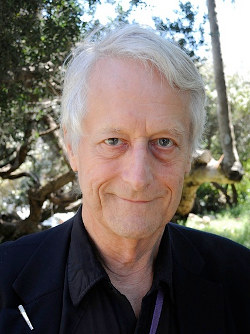
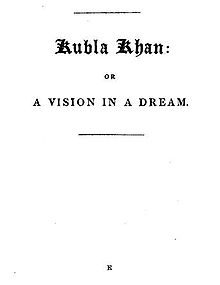
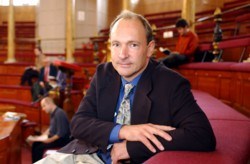






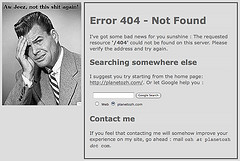




-small.svg.png)

